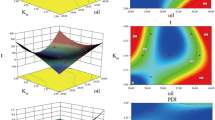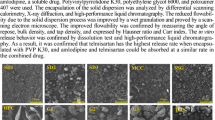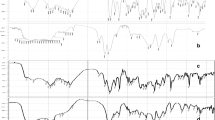Abstract
The objective was to improve the dissolution of valsartan by developing valsartan nanocrystals and design a pulsed release system for the chronotherapy of hypertension. Valsartan nanocrystals were prepared by sonication—anti-solvent precipitation method and lyophilized to obtain dry powder. Nanocrystals were directly compressed to minitablets and coated to achieve pulsatile valsartan release. Pharmacokinetic profiles of optimized and commercial formulations were compared in rabbit model. The mean particle size and PDI of the optimized nanocrystal batch V4 was reported as 211 nm and 0.117, respectively. DSC and PXRD analysis confirmed the crystalline nature of valsartan in nanocrystals. The dissolution extent of valsartan was markedly enhanced with both nanocrystals and minitablets as compared to pure valsartan irrespective of pH of the medium. Core minitablet V4F containing 5% w/w polyplasdone XL showed quickest release of valsartan, over 90% within 15 min. Coated formulation CV4F showed two spikes in release profile after successive lag times of 235 and 390 min. The pharmacokinetic study revealed that the bioavailability of optimized formulation (72.90%) was significantly higher than the commercial Diovan tablet (30.18%). The accelerated stability studies showed no significant changes in physicochemical properties, release behavior, and bioavialability of CV4F formulation. The formulation was successfully designed to achieve enhanced bioavailability and dual pulsatile release. Bedtime dosing will more efficiently control the circadian spikes of hypertension in the morning.






Similar content being viewed by others
References
Kasper DL, Braunwald E, Fauci AS, Hauser SL, Longo DL, Jameson JL. Harrison’s principles of internal medicine. 16th ed. New York: McGraw Hill; 2005.
Cugini P. The treatability of refractory or resistant hypertension by personalized antihypertensive chronotherapy based on ambulatory monitoring of the arterial pressure. Recent Prog Med. 1996;87:51–7.
Cugini P. Compliance and the chronotherapy of refractory arterial hypertension. Recent Prog Med. 1997;88:463–9.
Hermida RC, Calvo C, Ayala DE, Mojon A, Rodriguez M, Chayan L, et al. Administration time-dependent effects of valsartan on ambulatory blood pressure in elderly hypertensive subjects. Chronobiol Int. 2005;22:755–76.
Markham A, Goa KL, Valsartan. A review of its pharmacology and therapeutic use in essential hypertension. Drugs. 1997;54:299–311.
Nayak UY, Shavi GV, Nayak Y, Averinen RK, Mutalik S, Reddy SM, et al. Chronotherapeutic drug delivery for early morning surge in blood pressure: a programmable delivery system. J Control Rel. 2009;136(2):125–31.
Sokar MS, Hanafy AS, El-Kamel AH, El-Gamal SS. Pulsatile core-in-cup valsartan tablet formulations: in vitro evaluation. Asian J Pharm Sci. 2013;8:234–43.
Shah S, Patel R, Soniwala M, Chavda J. Development and optimization of press coated tablets of release engineered valsartan for pulsatile delivery. Drug Dev Ind Pharm. 2015;41:1835–46.
Brunella C, Cleelia DM, Maria I, Agnese M. Improvement of solubility and stability of valsartan by hydroxypropyl-β-cyclodextrin. J Incl Phenom Macro. 2006;54:289–94.
Dressman JB, Reppas C. In vitro in vivo correlations for lipophilic, poorly water-soluble drugs. Eur J Pharm Sci. 2000;S2:S73–80.
Crisp MT, Tucker CJ, Rogers TL, William RO, Johnston KP. Turbidimetric measurement and prediction of dissolution rate of poor soluble drug nanocrystals. J Control Release. 2007;117:351–9.
Jinno J, Kamada N, Miyaki M, Yamada K, Mukari T, Odomi M, et al. Effect of particle size reduction on dissolution and oral absorption of poor soluble drugs. J Control Release. 2006;111:56–64.
Park YJ, Lee HK, Im YB, Lee W, Han HK. Improved pH-independent dissolution and oral absorption of valsartan via the preparation of solid dispersion. Arch Pharm Res. 2010;33(8):1235–40.
Yan YD, Sung JH, Kim KK, Kim DW, Kim JO, Lee BJ, et al. Novel valsartan-loaded solid dispersion with enhanced bioavailability and no crystalline changes. Int J Pharm. 2012;422:202–10.
Liversidge GG, Cundy KC. Particle size reduction for improvement of oral bioavailability of hydrophobic drugs: I. Absolute oral bioavailability of nanocrystalline danazol in beagle dogs. Int J Pharm. 1995;125:91–7.
Guo Z, Zhang M, Li H, Wang J, Kougoulos E. Effect of ultrasound on antisolvent crystallization process. J Cryst Growth. 2005;273:555–63.
Kaerger JS, Price R. Processing of spherical crystalline particles via a novel solution atomization and crystallization by sonication (SAXS) technique. Pharm Res. 2004;21:372–81.
Zhang H, Hollis CP, Zhang Q, Li T. Preparation and antitumor study of camptothecin nanocrystals. Int J Pharm. 2011;415:293–300.
US Department of Health and Human Services, Food and Drug Administration. Guidance for industry: bioanalytical method validation. Rockville: Centre for Drugevaluation and Research; 2001.
Gao L, Zhang D, Chen M, Zheng T, Wang S. Preparation and characterization of an oridonin nanosuspension for solubility and dissolution velocity enhancement. Drug Dev Ind Pharm. 2007;33:1332–9.
Deng J, Huang L, Liu F. Understanding the structure and stability of paclitaxel nanocrystals. Int J Pharm. 2010;390:242–9.
Deng Z, Xu S, Li S. Understanding a relaxation behavior in a nanoparticle suspension for drug delivery applications. Int J Pharm. 2008;351:236–43.
Müller RH. Zetapotential und Partikeladung in der Laborpraxis. Suttgart: Wissenschaftliche Verlagsgeselschaft mbH; 1996.
Riddick TM. Zeta-meter manual. New York: Zeta-Meter Inc.; 1968.
Rabinow BE. Nanosuspensions in drug delivery. Nat Rev Drug Discov. 2004;3:785–96.
Xia DN, Quan P, Piao HZ. Preparation of stable nitrendipine nanosuspensions using the precipitation ultrasonication method for enhancement of dissolution and oral bioavailability. Eur J Pharm Sci. 2010;40:325–34.
Xu Y, Liu XY, Lian RY. Enhanced dissolution and oral bioavailability of aripiprazole nanosuspensions prepared by nano-precipitation/homogenization based on acid-base neutralization. Int J Pharm. 2012;438:287–95.
Joe JH, Lee WM, Park YJ, Joe KH, Oh DH, Seo YG, et al. Effect of the solid-dispersion method on the solubility and crystalline property of tacrolimus. Int J Pharm. 2010;395:161–6.
Oh DH, Park YJ, Kang JH, Yong CS, Choi HG. Physicochemical characterization and in vivo evaluation of flurbiprofen-loaded solid dispersion without crystalline change. Drug Deliv. 2011;18:46–53.
Noyes AA, Whitney WR. The rate of solution of solid substances in their own solutions. J Am Chem Soc. 1897;19:930–4.
Gonnissen Y, Remon JP, Vervaet C. Effect of maltodextrin and superdisintegrant in directly compressible powder mixtures prepared via co-spray drying. Eur J Pharm Biopharm. 2008;68:277–82.
Zhang Y, Wang J, Bai X, Jiang T, Zhang Q, Wang S. Mesoporous silica nanoparticles for increasing the oral bioavailability and permeation of poorly water soluble drugs. Mol Pharm. 2012;9:505–13.
Clark M, Jepson MA, Hirst BH. Exploiting M cells for drug and vaccine delivery. Adv Drug Deliv Rev. 2001;50:81–106.
Acknowledgments
We greatly acknowledge the Department of Science & Technology, Delhi (SR/FT/LS-21/2011) for funding this research. We would also like to thank BASF, USA and Ranbaxy Laboratories Ltd., India, for their free gift samples.
Author information
Authors and Affiliations
Corresponding author
Ethics declarations
The study protocol was reviewed and approved by the Institutional Ethics Committee, Jadavpur University, Kolkata.
Conflict of Interest
The authors report no conflicts of interest.
Rights and permissions
About this article
Cite this article
Biswas, N., Kuotsu, K. Chronotherapeutically Modulated Pulsatile System of Valsartan Nanocrystals—an In Vitro and In Vivo Evaluation. AAPS PharmSciTech 18, 349–357 (2017). https://doi.org/10.1208/s12249-016-0511-5
Received:
Accepted:
Published:
Issue Date:
DOI: https://doi.org/10.1208/s12249-016-0511-5




